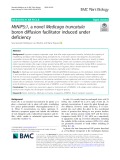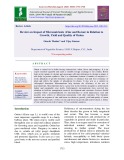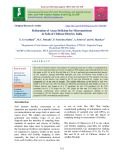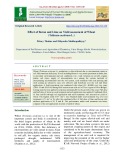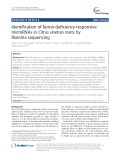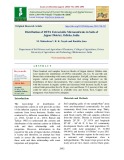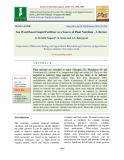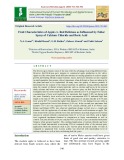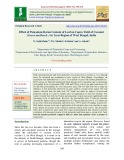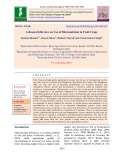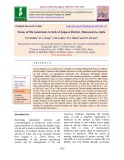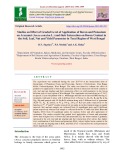
Boron deficiency
-
Nanosuspensions (NS) are one of the new generation drug carrier forms developed to overcome the deficiencies of drugs with poor water solubility or insolubility and are considered to be one of the most successful approaches to formulate compounds in recent years. Boron nitride (BN) is insoluble in water and chemically more stable than carbon, it offers better biological superiority although the application of carbon structures in the biomedical field has increased in recent years
 21p
21p  lyhuyenthu
lyhuyenthu
 31-01-2023
31-01-2023
 6
6
 2
2
 Download
Download
-
Legumes comprise important crops that offer major agronomic benefits, including the capacity of establishing symbiosis with rhizobia, fixing atmospheric N2. It has been proven that legumes are particularly susceptible to boron (B) stress, which leads to important yield penalties.
 13p
13p  vijichea2711
vijichea2711
 28-05-2021
28-05-2021
 14
14
 1
1
 Download
Download
-
Deficiency of micronutrients during the last three decades has grown in both, magnitude and extent. This has become a major constraint to production and productivity of vegetables in general and onion in particular. Bhonde et al., (1995) evaluated the effect of zinc, copper and boron on onion crop. Bulb size and yield as well as quality of bulb enhanced when micronutrients were applied in combinations instead of their single application.micronutrients, Zinc and Boron, Quality of Onion
 8p
8p  cothumenhmong11
cothumenhmong11
 11-05-2021
11-05-2021
 18
18
 2
2
 Download
Download
-
After nitrogen, phosphorus and potassium, sulphur is the fourth nutrient, whose deficiency is widespread in India. Sulphur deficiency is observed primarily due to high crop yield and therefore higher rate of sulphur removal by crops, and lesser use of sulphur-containing fertilizers. Boron foliar sprays seemed to overcome the deleterious effects of drought by overcoming the drought-related molecular responses and consequently appeared to meliorate sunflower growth under insufficient water conditions.
 7p
7p  gaocaolon9
gaocaolon9
 22-12-2020
22-12-2020
 15
15
 2
2
 Download
Download
-
The soils of Chittoor district was found to be suffering from one or other or combination of two or more micronutrients in 324 out of analysed 576 samples and constituted 56 per cent (Zn alone in 103, Fe in 40, B in 60, Mn in 5, Cu in 5 and multi micronutrient deficiencies in 107 samples). Among individual nutrients, the soils of Chittoor were found to be deficient in available zinc to an extent of 33 per cent and boron in 21% samples.
 9p
9p  nguathienthan8
nguathienthan8
 20-10-2020
20-10-2020
 9
9
 2
2
 Download
Download
-
Wheat (Triticum aestivum L.) production is often affected due to micronutrient status in soil. Micronutrient deficiency in soil including Boron is very much prominent in India, due to prevalent environmental and soil conditions (viz., wide variation in soil pH, organic matter, salt stress, supply of micronutrients etc.) among the various methods of incorporating micronutrients into the soil system, seed treatment with seed priming and seed coating are attractive, easy cost effective and beneficial over the soil and foliar application.
 8p
8p  quenchua6
quenchua6
 15-06-2020
15-06-2020
 13
13
 1
1
 Download
Download
-
A field experiment comprising recommended package of practices (RPP), RPP + soil (2.5 and 5.0 kg ha-1 at 10 DAS), foliar (0.5 and 1.25 % at 45 DAS) application of solubor and combination of both soil and foliar application was conducted during kharif 2017 at the MARS, University of Agricultural Sciences, Dharwad, Karnataka to study the boron nutrition effect on growth, nodulation, yield attributes and yield of soybean in boron deficient Vertisol. A Randomized Complete Block Design was used for the experiment with three replications.
 8p
8p  gaocaolon5
gaocaolon5
 14-06-2020
14-06-2020
 10
10
 1
1
 Download
Download
-
Boron (B)-deficiency is a widespread problem in many crops, including Citrus. MicroRNAs (miRNAs) play important roles in nutrient deficiencies. However, little is known on B-deficiency-responsive miRNAs in plants.
 16p
16p  viminato2711
viminato2711
 22-05-2020
22-05-2020
 5
5
 0
0
 Download
Download
-
MicroRNAs play important roles in the adaptive responses of plants to nutrient deficiencies. Most research, however, has focused on nitrogen (N), phosphorus (P), sulfur (S), copper (Cu) and iron (Fe) deficiencies, limited data are available on the differential expression of miRNAs and their target genes in response to deficiencies of other nutrient elements.
 15p
15p  vihashirama2711
vihashirama2711
 21-05-2020
21-05-2020
 17
17
 1
1
 Download
Download
-
Three hundred soil samples from ten blocks of Jajpur district, Odisha state were studied for distribution of DTPA extractable. Zn, Cu, Fe and Mn and Boron their relationship with some soil properties. Soil pH, calcium carbonate, organic carbon and particle-size fractions had strong influence on the distribution of these micronutrients. The content of micronutrient increased with the increase in organic carbon and decreased with increase in pH. As per critical limit prescribed for Zn 26 per cent and Boran 73.3 percent of the soil could be rated as deficient in available zinc and boron.
 5p
5p  chauchaungayxua5
chauchaungayxua5
 08-05-2020
08-05-2020
 10
10
 1
1
 Download
Download
-
Plant nutrients are classified as major (Nitrogen (N), Phosphorus (P) and Potassium (K), calcium (Ca), magnesium (Mg) and sulfur (S). They are also enquired in relatively large amounts but are less likely to be deficient. Micronutrients [boron(B), copper (Cu), iron (Fe), manganese (Mn), molybdenum (Mo) and zinc (Zn)0. C
 6p
6p  kethamoi4
kethamoi4
 18-04-2020
18-04-2020
 6
6
 1
1
 Download
Download
-
The diverse agro climatic zones of the state offer the advantage of growing different fruits. However, Red Delicious gave impetus to commercial apple production in the valley. Apple tree like other plants needs different nutrients in varying quantities to achieve proper growth and fruiting. Besides major elements, macro and micro nutrients are also required in small quantities that assume critical importance when deficient as these are taken up by the plant and need to be replenished. In many cases the quality of harvest produce is determined by the content of the mineral nutrients.
 7p
7p  trinhthamhodang1212
trinhthamhodang1212
 06-04-2020
06-04-2020
 13
13
 2
2
 Download
Download
-
The occurrence of micronutrient deficiencies in crops has increased markedly in recent years due to intensive cropping, soil erosion, leaching, liming of acid soils, reduced use of manures, increased purity of chemical fertilizers and use of marginal lands for crop production. Among the micronutrients, the boron plays an important role in flowering and fertilization process and hence boosting yield and quality of crop produce.
 7p
7p  quenchua4
quenchua4
 06-04-2020
06-04-2020
 16
16
 1
1
 Download
Download
-
Wide spread potassium and boron deficiency in coconut (Cocos nucifera L.) is a limiting factor for increased nut production in terai region of West Bengal. Accordingly, an experiment was undertaken in a 7.5 m x 7.5 m spaced 11 years old coconut plantation (cv. ECT) laid out in Factorial randomized block design with 9 treatments and 4 replications with graded levels of potassium (900, 1200 and 1500 g of K2O per palm) and boron (25, 50, and 100 g borax/palm) for two consecutive years (2014-15 and 2015-16) to study the influence of leaf potassium and boron on copra yield in coconut in the region.
 13p
13p  cothumenhmong4
cothumenhmong4
 25-03-2020
25-03-2020
 18
18
 2
2
 Download
Download
-
Fruit Crops yield and quality significantly increase with the use of micronutrients such as zinc (Zn), iron (Fe), Calcium (Ca) Magnesium (Mg) Boron (B), Copper (Cu), Manganese (Mn), etc. Zinc (Zn) has an important metabolically role in plants vegetative and reproductive phases; growth and development; is therefore called an essential trace element or a micronutrient.
 12p
12p  caygaocaolon3
caygaocaolon3
 27-02-2020
27-02-2020
 30
30
 1
1
 Download
Download
-
An investigation was carried out at All India Co-ordinated Research Project on Micro and Secondary Nutrients and Pollutant Elements in Soils and Plants under Department of Soil Science & Agricultural Chemistry, Dr. Panjabrao Deshmukh Krishi Vidyapeeth, Akola, Maharashtra to assess the chemical properties, available sulphur and micronutrients status in soils of Jalgaon district in the year 2017-18. GPS based 480 soil samples (0-20 cm) from 15 tehsils in Jalgaon district of Maharashtra at 5 km grid were collected and analysed in the laboratory.
 8p
8p  trinhthamhodang3
trinhthamhodang3
 14-02-2020
14-02-2020
 38
38
 1
1
 Download
Download
-
A field experiment was conducted to study the effect of zinc and boron levels on yield, quality and nutrient uptake in mustard under Northern transition zone of Karnataka during rabi, 2017 at MARS, UAS, Dharwad with 10 treatments. The treatment comprised of two levels of zinc (10 kg ha-1 and 20 kg ha-1 ) and two levels of boron (1 kg ha-1 and 2 kg ha-1 ) and their combinations. These treatments were compared with RDF + FYM @ 5 t ha-1 and RDF (60:50:40 N: P2O5: K2O) alone. The treatments were replicated thrice in a randomized block design.
 6p
6p  chauchaungayxua3
chauchaungayxua3
 07-02-2020
07-02-2020
 14
14
 0
0
 Download
Download
-
A study was undertaken to assess the soil fertility status of Korasagu-4 micro-watershed in Channagiri taluk, Davanagere district of Karnataka. Total ninety six grid wise surface soil samples were collected at 0-15 cm depth to assess the soil parameters and prepare thematic maps by using GIS techniques. The results indicated that soils of micro watershed were slightly acidic to strongly alkaline in soil reaction with non-saline in nature. Soil organic carbon content was found to be medium in major area. The available N, P2O5, K2O were found to be low (73.37%), medium (94.65%) and high (58.
 11p
11p  nguathienthan2
nguathienthan2
 26-12-2019
26-12-2019
 8
8
 0
0
 Download
Download
-
The experiment was conducted during the year 2017-18 at the instructional farm of Department of Plantation Crops and Processing, Faculty of Horticulture, Uttar Banga Krishi Vishwavidyalaya, West Bengal. The study was aimed to evaluate the effect of graded level application of boron and potassium and their interaction on boron content in soil, leaf and nut (mg/kg) and their interaction effect on yield parameter in the boron deficient soils of terai region of West Bengal. The experiment was carried out in a 2.7×2.7 m spaced 12 year old planted with cv.
 8p
8p  kequaidan2
kequaidan2
 13-12-2019
13-12-2019
 18
18
 0
0
 Download
Download
-
The effects of excess and deficient boron and niacin on vascular tissues of carrot roots (Daucus carota L. cv. Nantes) were investigated in plants grown in medium both rich and poor in boron and also boron with niacin.
 7p
7p  vi4mua
vi4mua
 24-02-2019
24-02-2019
 10
10
 0
0
 Download
Download
CHỦ ĐỀ BẠN MUỐN TÌM










